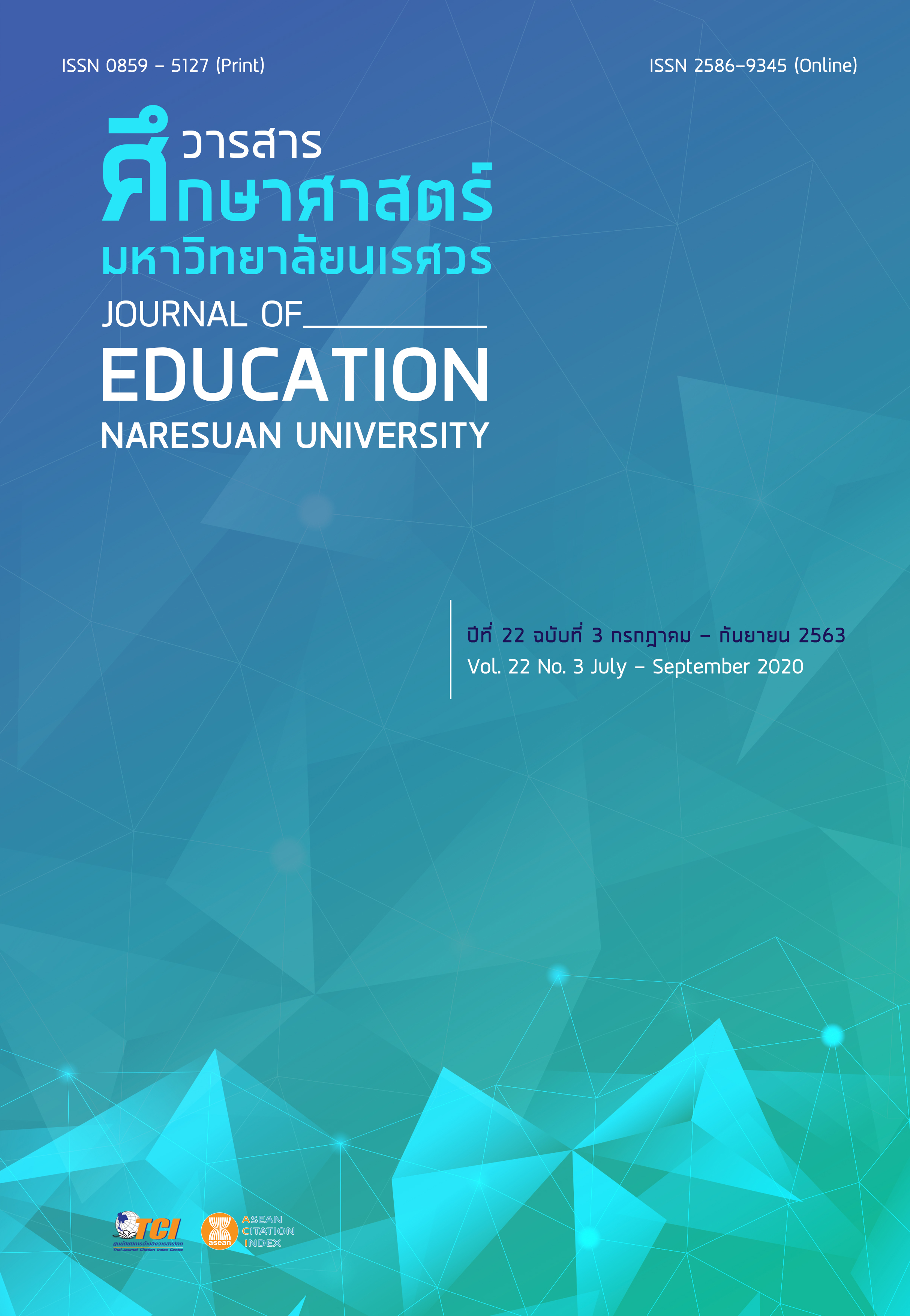MULTIPLICATIVE DISCOURSE FOR MAKING PATTERNS IN MULTIPLICATION TABLE IN AN OPEN APPROACH CLASSROOM TEACHING: A SEMIOTIC ANALYSIS
Main Article Content
Abstract
The aim of this study was to analyze multiplication discourse for making patterns in multiplication table emerging in a mathematics classroom taught through open approach. The research was carried out in one second grade classroom in the project school innovated by Lesson Study and Open Approach. Qualitative methods were employed for collecting and analyzing data through classroom observation on 11 consecutive lessons on multiplication. Teaching protocols, students’ written works, field notes and classroom photographs were used as the research data. Semiotic analysis with protocol analysis was employed in this study. The research result revealed what and how multiplicative discourse of students and teacher played a major role in discovering meaning of multiplication and constructing multiplication tables in each steps of open approach as a teaching approach. Two types of multiplicative discourse found in making patterns in multiplication tables were univocal and dialogic discourse. Univocal discourse like “number set”, “adding it up”, “multiplier increases by 1” and “answers increase by…” students use played a role in drawing arrows to represent various way of algebraic pattern after making multiplication by themselves. Dialogic discourse as teacher’s revoicing of students’ thinking in classroom discussion helped students to reflect and adjust complex algebraic pattern embedded in multiplication tables. The findings showed a construction of a semiotic system of multiplicative discourse included a set of multiplication signs, rules of multiplication sign production and relationship between the signs and their meanings.
Article Details
The owner of the article does not copy or violate any of its copyright. If any copyright infringement occurs or prosecution, in any case, the Editorial Board is not involved in all the rights to the owner of the article to be performed.
References
Ball, D. L. (1991). What’s all this talk about “discourse”? Arithmetic Teacher, 39, 44-48.
Cobb, P., Boufi, A., McClain, K., & Whitenack, J. (1997). Reflective discourse and collective reflection. Journal for Research in Mathematics Education, 28(3), 258-277.
Cobb, P. (2000). From representing to symbolizing: Introductory comments on semiotics and mathematical learning, In E. Yackel, P. Cobb and K. Mcclain (Eds.), Symbolizing and Communicating in Mathematics Classrooms: Perspective on Discourse, Tool and Instructional Design. Mahwah, NJ: Lawrence Erlbaum Associates.
Hufferd-Ackles, K. (1999). Learning by all in a Math-TALK community (Doctoral dissertation). Evanstion, IL: Northwestern University.
Inprasitha, M. (2010). One feature of adaptive lesson study in Thailand: Designing learning unit. Proceedings of the 45th Korean National Meeting of Mathematics Education (pp.193-206). Gyeongju: Dongkook University.
Isoda, M. (2010). Japanese theories for lesson study in mathematics education: A case of problem-solving approach, In Y. Shimizu, Y. Sekiguchi and K. Hatano (Eds.), Proceedings of the 5th East Asia Regional Conference on Mathematics Education (EARCOME5) (pp. 176-181). Tokyo: National Olympics Memorial Youth Center.
Jacob, L., & Willis, S. (2001). Recognising the difference between additive and multiplicative thinking in young children. In J. Bobis, B. Perry & M. Mitchelmore. (Eds.), Numeracy and beyond Proceedings of the 24th Annual Conference of the Mathematics Education Research Group of Australasia, Sydney (pp. 306-313). Sydney: MERGA.
Kazemi, E. (1999). Discourse that promotes conceptual understanding. Teaching Children Mathematics, 4(7), 410-414.
Kinard, J. T., & Kozulin, A. (2008). Rigorous mathematical thinking: Conceptual formation in the mathematics classroom. New York: Cambridge University Press.
Lampert, M. (1990). When the problem is not the question and the solution is not the answer: Mathematical knowing and teaching. American Educational Research Journal, 27, 29-63.
Lotman, Y. M. (1988). The semiotics of culture and the concept of a text. Soviet Psychology, XXVI(3), 52-58.
National Council of Teachers of Mathematics. (2000). Principles and standards for school mathematics. Reston: The National Council of Teachers of Mathematics.
Sangpom, W. (2015). Mathematical connections for learner’s knowledge creation. Journal of Education Naresuan University, 16(4), 210-215.
Sfard, A. (2002). There is more to discourse than meets the ears: Looking at thinking as communicating to learn more about mathematical learning, In C. Kieran, E. Forman, and A. Sfard (Eds.), Learning Discourse: Discursive Approaches to Research in Mathematics Education. Boston: Kluwer.
Sonpang, J., & Sangpan, J. (2017). Supporting students’ geometric problem – solving abilities in classroom taught through open approach. Journal of Education Naresuan University, 19(4), 65-77.
Suttiamporn, W. (2015). Mathematical activity emphasized on connection among knowledge and ideas for fostering students’ creativity. Journal of Education Naresuan University, 16(4), 93 -103.
Van Oers, B. (2000). The appropriation of mathematical symbols: A psychosomatic approach to mathematics learning, In P. Cobb, E. Yackel and K. McClain (Eds.), Symbolizing and Communicating in Mathematics Classrooms. Erlbaum, Mahwah.
Van der Veer, R. & Valsiner, J. (1991). Understanding Vygotsky: A quest for synthesis. Cambridge, MA.: Blackwell.
Vygotsky, L. S. (1929). The problem of the cultural development of the child. The Pedagogical Seminary and Journal of Genetic Psychology, 36(3), 415-434.
Vygotsky, L. S. (1978). Mind in society: The development of higher psychological processes. Cambridge: Harvard University Press.
Wertsch, J. V., & Toma, C. (1995). Discourse and learning in the classroom: A sociocultural approach. In L. P. Steffe & J. Gale (Eds.), Constructivism in education (pp. 159-174). Hillsdale, NJ: Lawrence Erlbaum.
Yoshida, M. (1999). Lesson study: A case study of a Japanese approach to improving instruction through school-based teacher development (Doctoral dissertation). Illinois: The University of Chicago.


